|
engineering questions
|
View this Thread in Original format
| King_Mack |
hey guys..had two questions for y'all, see if you guys can solve it. And NO...this is NOT a homework question hehe. Lemme know what you guys come up with..thanks a ton :)
(i know..this is a chem question..but whatever)
Problem 1
A solid sphere (of radius R and density r) made of substance A (of molecular weight M) is suspended in a liquid B. Solid A undergoes a first-order homogeneous chemical reaction with rate constant k1''' being slightly soluble in liquid B. Let Cao be the molar solubility of A in B, and Dab be the diffusivity of A in B.
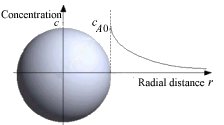
Figure. Diffusion with chemical reaction of sphere in liquid.
a) Establish the concentration profile for A at steady state (i.e., when the mass diffusion is in exact balance with the chemical reaction).
b) Using a quasi-steady-state approach, derive an expression for the time t required for the sphere radius to decrease from an initial radius Ro to R.
Problem 2
An incompressible isothermal liquid in laminar flow is open to the atmosphere at the top. Determine the shape of the free liquid surface z(r) at steady state (neglecting end effects, if any) for the following cases:
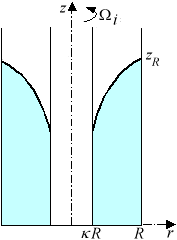 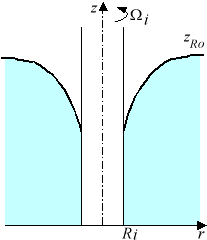
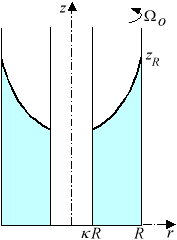 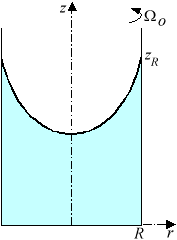
Figure. Free surface shape of liquid in four cases of tangential flow.
a) when the liquid is in the annular space between two vertical coaxial cylinders, whose inner and outer wetted surfaces have radii of k R and R, respectively. Here, the inner cylinder is rotating at a constant angular velocity (Omega)i and the outer cylinder is stationary. Let Zr be the liquid height at the outer cylinder.
b) when a single vertical cylindrical rod of radius Ri is rotating at a constant angular velocity (omega)i in a large body of quiescent liquid. Let zRo be the liquid height far away from the rotating rod.
Hint: Use the result in a).
c) when the liquid is in the annular space between two vertical coaxial cylinders, whose inner and outer wetted surfaces have radii of k R and R, respectively. Here, the outer cylinder is rotating at a constant angular velocity Wo and the inner cylinder is stationary. Let zR be the liquid height at the outer cylinder.
d) when the liquid is in a vertical cylindrical vessel of radius R, which is rotating about its own axis at a constant angular velocity (omega)o. Let Zr be the liquid height at the vessel wall.
Hint: Use the result in c). |
|
|
| Photo_bot_2k1 |
1a. 2
1b. 5.6
2a. elephants
2b. -2488
2c. left
2d. :clown: |
|
|
| Dmatrox |
| quote: | Originally posted by King_Mack
And NO...this is NOT a homework question hehe. Lemme know what you guys come up with..thanks a ton :)
|
you do this for fun? :eek: :nervous: |
|
|
| Windex_ |
Question #2 is fairly easy... let me get my fluid mechanics book and I'll get back to you.
EDIT
ok here's 2 D)
in term of cylindrical coordinates, the pressure gradient can be expressed as ("d" stands for partial derivate, "D" for total)
Dp=dp/dr*Dr+dp/dz*Dz+dp/d(theta)*D(theta)
and knowing that
dp/dr=rho(r)(omega)^2
dp/d(theta)=0
dp/dz=-gamma
we find that
dp=rho*r*omega^2*Dr-gamma*Dz
along a surface of constant pressure, such as the free surface, dp=0 so we get using gamma= rho*g:
dz/dr=r*omega^2/g
we integrate the last expression and we get something like :
z=omega^2*r^2/(2*g)+constant
where the constant would be the height of liquid at the axis of rotation.
I hope it answers your question...
:D |
|
|
| Z1D |
| Silly ChemE's, PhysE break out some quauntum for these hoes :cool: |
|
|
| starglider |
Engineering  |
|
|
|
|